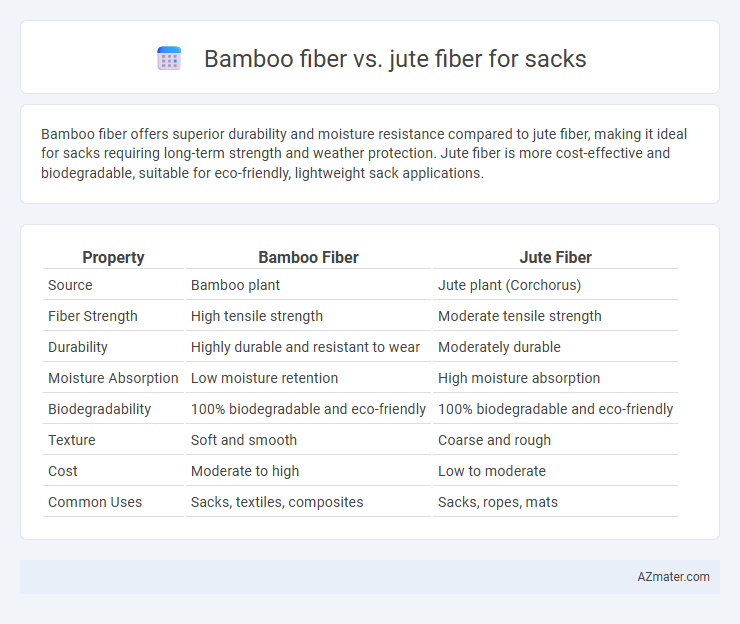Bamboo fiber offers superior durability and moisture resistance compared to jute fiber, making it ideal for sacks requiring long-term strength and weather protection. Jute fiber is more cost-effective and biodegradable, suitable for eco-friendly, lightweight sack applications.
Table of Comparison
| Property | Bamboo Fiber | Jute Fiber |
|---|---|---|
| Source | Bamboo plant | Jute plant (Corchorus) |
| Fiber Strength | High tensile strength | Moderate tensile strength |
| Durability | Highly durable and resistant to wear | Moderately durable |
| Moisture Absorption | Low moisture retention | High moisture absorption |
| Biodegradability | 100% biodegradable and eco-friendly | 100% biodegradable and eco-friendly |
| Texture | Soft and smooth | Coarse and rough |
| Cost | Moderate to high | Low to moderate |
| Common Uses | Sacks, textiles, composites | Sacks, ropes, mats |
Introduction to Natural Fibers for Sacks
Natural fibers such as bamboo and jute are essential materials for producing durable, sustainable sacks with high tensile strength and biodegradability. Bamboo fiber is known for its fine texture, rapid growth rate, and antibacterial properties, making it a sustainable alternative, while jute fiber offers coarse texture, high moisture resistance, and excellent breathability suited for packaging agricultural products. Selecting between bamboo and jute fibers depends on factors like fiber strength, environmental impact, and intended sack use, emphasizing the importance of natural fiber properties in sustainable sack manufacturing.
Overview of Bamboo Fiber
Bamboo fiber, derived from the pulp of bamboo grass, offers high durability and natural antibacterial properties, making it a sustainable and hygienic choice for sacks. Compared to jute fiber, bamboo is softer, more moisture-resistant, and less prone to degradation under humid conditions, enhancing the longevity of storage sacks. Its rapid growth rate and eco-friendly processing provide an environmentally responsible alternative in the production of durable and reusable packaging materials.
Overview of Jute Fiber
Jute fiber is a natural vegetable fiber obtained from the outer bast of the jute plant, known for its strength, durability, and biodegradability, making it ideal for sacks and packaging. It is lightweight, cost-effective, and has excellent breathability, which helps protect goods like agricultural produce during transportation and storage. Jute sacks also offer high moisture resistance and are eco-friendly, positioning them as a sustainable alternative to synthetic materials in the sack industry.
Environmental Impact: Bamboo vs Jute
Bamboo fiber and jute fiber both offer sustainable alternatives for sack production, but bamboo boasts a faster growth rate and higher carbon sequestration, significantly reducing its environmental footprint. Bamboo cultivation requires less water and pesticides compared to jute, further minimizing ecological damage. However, jute is highly biodegradable and supports soil health by enriching nitrogen content, making it beneficial for crop rotation and long-term agricultural sustainability.
Durability and Strength Comparison
Bamboo fiber offers superior tensile strength and flexibility compared to jute fiber, making it more resistant to wear and tear in heavy-duty sack applications. Jute fiber, while cost-effective and biodegradable, tends to have lower tensile strength and may degrade faster under prolonged exposure to moisture and rough handling. Bamboo fiber's natural antimicrobial properties and higher durability extend the lifespan of sacks, providing enhanced performance in various environmental conditions.
Cost-Effectiveness of Bamboo and Jute Sacks
Bamboo fiber sacks offer competitive cost-effectiveness due to their rapid growth rate and sustainable harvesting, resulting in lower raw material costs compared to jute. Jute fiber sacks, while traditionally more affordable and widely used, may incur higher expenses related to slower cultivation and processing times. The durability and biodegradability of bamboo fiber also contribute to long-term savings by reducing replacement frequency and environmental impact fees.
Breathability and Moisture Control
Bamboo fiber exhibits superior breathability compared to jute fiber due to its micro-gaps in the fiber structure, allowing better air circulation in sacks. Moisture control is enhanced in bamboo fiber sacks as they possess natural antimicrobial properties and high absorbency, reducing the risk of mold and mildew. Conversely, jute fiber, while durable, tends to retain moisture longer, making it less effective for applications requiring optimal breathability and moisture management.
Production Process: Bamboo vs Jute
Bamboo fiber production involves mechanically crushing bamboo stalks followed by enzymatic or chemical retting to extract fibers, resulting in strong, long strands ideal for sacks. Jute fiber is obtained through water retting, where stalks are submerged to soften the bark before fibers are manually stripped, producing coarse but durable material. Bamboo's quicker growth and eco-friendly processing contrast with jute's labor-intensive retting process and seasonal cultivation.
Biodegradability and End-of-Life Disposal
Bamboo fiber and jute fiber both offer excellent biodegradability, making them environmentally friendly options for sack production. Bamboo fiber decomposes rapidly due to its natural antimicrobial properties, enhancing soil health without harmful residues after disposal. Jute fiber, known for its strong and durable composition, also biodegrades efficiently, returning nutrients to the soil and supporting sustainable end-of-life disposal practices.
Choosing the Best Fiber for Sack Manufacturing
Bamboo fiber offers superior moisture resistance, durability, and eco-friendliness compared to jute fiber, making it an excellent choice for sack manufacturing in humid environments. Jute fiber is cost-effective and has high tensile strength, suitable for short-term, lightweight sacks but is prone to mold and degradation if exposed to moisture. Selecting bamboo or jute fiber depends on the specific requirements of the sack use case, balancing factors like environmental impact, strength, and longevity.

Infographic: Bamboo fiber vs Jute fiber for Sack
 azmater.com
azmater.com